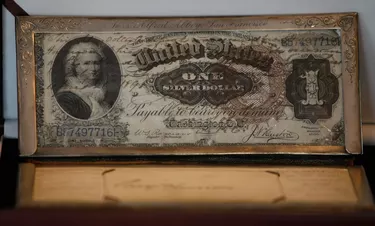
After an act of Congress passed in 1878, the United States Treasury issued silver certificates that holders could redeem for an equivalent value in silver. Although redemption is no longer an option, silver certificates still circulate. As the last issues took place in the 1960s, they have become increasingly rare, and notes issued in certain years can be worth more than $1,000.
The End of Silver Redemption
Video of the Day
In 1963, the US Treasury ceased making silver certificates. In 1964, the Secretary of the Treasury ended the redemption of silver certificates for silver coins; in 1968 redemption for silver bullion ended. The redemption feature for "hard money" no longer made economic sense for the Treasury Department, therefore the public was no longer able to redeem the notes. However, silver certificates remain legal tender, meaning they can be used to make purchases.
Video of the Day
Checking for Authenticity
Check your note carefully. These bills show the words "Silver Certificate" on the obverse (portrait) side, running across the top and centered. The serial numbers and the seal on the right panel of the obverse side are blue. Genuine silver certificates come in $1, $5 and $10 denominations. The bills are worth more if they're in "uncirculated" or unused condition; traders commonly keep these valuable notes in protective Mylar covers. A star symbol at the beginning of the serial number--or simply a low serial number--raises the note's value.
Appraising Your Notes
Before offering your silver certificate to anyone, bring it to at least two coin and currency dealers to have its value appraised. Your note may be worth much more than its face value if it's particularly rare and in mint condition. The 1928 silver certificates, for example, are worth anywhere from $10 to $150, depending on their series, and the $10 silver certificate from 1933 can bring up to $1,500. Larger bills from the 19th century are comparatively rare and much more valuable.
Going Online
Exchange your silver certificate for cash at the dealer, who should be able to offer close to appraised value, or post it online for an auction sale. Use a site with a good coin and currency market, with recent auctions that will allow you to research current value of your note. Search recently closed auctions, and follow any auctions that are still open, to get a feel for value. You can set a floor bid, which requires a minimum winning bid, but you will pay some fees to the site for the service of running the auction.